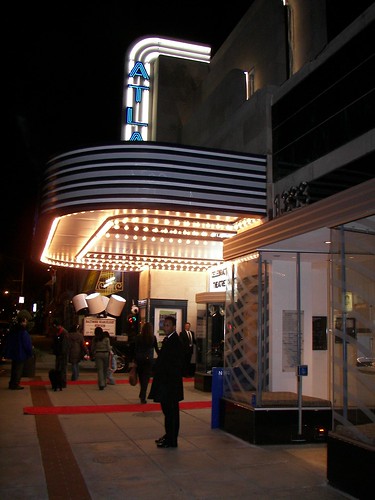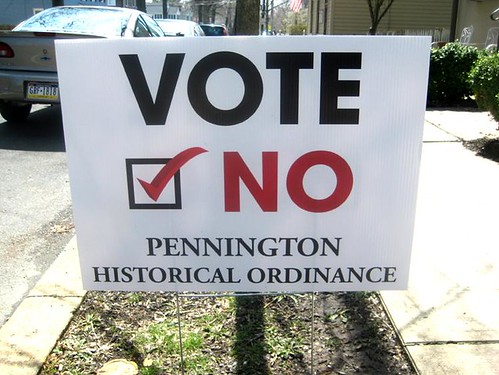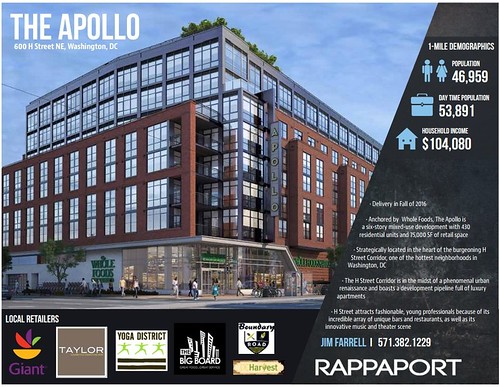Government officials (and advocates) typically don't plan for opposition: streetcar edition
Image from Theatre Washington.
This past Sunday was a memorial service for Paul Sprenger, husband of Jane Lang, both of whom were nationally prominent attorneys in the field of gender-, age-, and race-based employment discrimination ("Paul Sprenger, Lawyer Who Fought Discrimination, Dies at 74," New York Times).
It was at the Atlas Performing Arts Center ("Jane Lang, the spark behind H Street's Atlas theater, steps out," Washington Post), which before the involvement of Jane Lang, with the stalwart participation of her husband, had been mouldering for decades. Owned by the H Street Community Development Corporation, the asset was empty and the HSCDC was considering tearing part of it down, for parking.
The commitment to renovate the Atlas in 2002, construction and the subsequent re-opening in 2005/2006 was one of the seminal events fundamental to the current success of revitalization on H Street today.
 Commiserating about the streetcar. I was surprised though that at the service, very few "H Street" related people had come, although there were plenty of people affiliated somehow with the Atlas. Most of the attendees seemed to know Paul or Jane in non-H Street contexts.
Commiserating about the streetcar. I was surprised though that at the service, very few "H Street" related people had come, although there were plenty of people affiliated somehow with the Atlas. Most of the attendees seemed to know Paul or Jane in non-H Street contexts.At the reception, I was talking with one of the "H Street" people I knew, who had worked for the Atlas for a long time.
As is typical in current conversations with people involved in the H Street revitalization effort, we lamented the streetcar "program" -- how the city has managed it poorly, which is why it has taken so long to come to fruition, missed dates for starting service, and all of the opposition that has cropped up as a result, people's complaints, etc.
E.g., one of my points is that if you see tracks and overhead wires, that ought to be a "cue" that streetcars are going to be implemented and that you need to take better care to park between the line and curb.
She mentioned how much animosity there is over this and related issues, and I commented how tough love--getting your car T-boned because you run a red light in front of a streetcar, or getting your car towed for double parking--is the absolute best way to "re-educate" people on co-existing with a streetcar. Although as she said, DDOT has been putting out information about this for more than 12 months.
Expect opposition to land use and transportation change and prepare yourself to respond. But the big thing we discussed is the general opposition that gets expressed about the streetcar.
She says part of it is because people were told things that were not true as it turned out, in terms of when the service would start, where it would go, etc.
For example, planning failures by the government prevented the creation of a better connection with Union Station ("H Street Trolley Won't Get Direct Connection to Union Station," Washington City Paper).
She specifically felt burned by/lied to over and over by DDOT. Because she went out into the community as an advocate for the streetcar, in some respects the misrepresentations ended up seriously hurting her credibility as a representative of the Atlas and as a community member.
 (Not a DC sign.)
(Not a DC sign.)I said the biggest thing that I learned from being involved in historic preservation in the H Street neighborhood first in 2001, later in Brookland (2007), and through observation, is that the DC Historic Preservation Office does not acknowledge that there will be opposition and doesn't educate advocates about this.
Advocates need to be "instructed" to expect opposition, to plan for it, to have their arguments honed, materials prepared, etc., before they even start to go out in the community with information about why a neighborhood is worth designating and their proposal for the creation of a historic district.
That lesson is extendable to most land use and transportation matters. There will be opposition. Expect it. Plan for it. If you don't plan for it and respond, you will constantly be playing defense.
And likely you will lose.
Planners and other public officials typically don't articulate very well the benefits to residents from specific land use and transportation changes. So many public officials of all types (appointed or elected) are such good speakers on many topics.
That's why I am so surprised that all too often, when it comes to outlining "benefits" from changes in land use or the development of transportation projects, public officials haven't laid out the benefits and practiced their arguments extensively, before going out in the community.
The economic return from the H Street streetcar is already considerable. While I wouldn't pick streetcars to be the #1 transit priority of the District of Columbia, there is no question that already--and the service isn't even in operation---hundreds of millions of dollars of real estate development is occurring on H Street now, and it wouldn't be happening without the streetcar.
Basically any project east of 4th Street NE is being built with the expectation of streetcar service.

The Apollo mixed use residential and retail project at 600 H Street NE, will have a Whole Foods supermarket as part of 75,000 s.f. of retail and 430 apartments. The construction value of the project is $189 million.
Besides this project, two others (H Street Connection, Jair Lynch Development Partners at 625 and 645 H Street NE) within a couple blocks of The Apollo represent an investment of at least $270 million. These projects, some of which had been discussed for years, but hadn't moved forward until streetcar service became more certain, are now happening, and total about $460 million in new/re-newed investment.
A new CVS, at 7th Street and H Streets NE opened earlier this week. (A CVS had been on this block for many years but closed in favor of a consolidated store on Bladensburg Road, which opened about 8 years ago.)
These particular projects will bring about 130,000 square feet of new retail--in fact a new CVS has already opened--slightly more than 1,100 new housing units and about 2,000 new residents, as well as upgrading a building leased to the DC Government, which will continue to operate it, supporting some office use on the corridor.
So why is it that these returns/benefits aren't being cogently articulated? That's a pretty big economic return for a transit service that hasn't even started.
Especially when other projects, albeit mostly smaller, are also underway or in development. There's even a new proposal for the redevelopment of the single use CVS at the intersection of Bladensburg and Benning Roads.
So why is it that I can articulate such returns--and these are only some of the benefits--while people working on streetcars and planning for the city or its agents seem tongue-tied? And the opponents are still getting more traction than the proponents?
=====
Note that it was witnessing the creation of NoMA Metrorail station as infill development, which opened in 2004, and the multi-billion dollar economic impact on at least five distinct parts of the area--the neighborhood north of H Street; the blocks along 2nd Street NE/Delaware Avenue; NoMA west of the railyard; the area now termed Union Market; and Washington Gateway and the area north of New York Avenue in Eckington--which converted me towards becoming a transportation planner.
When done right, public investment in transportation infrastructure, particularly transit, especially in the context of a robust transit network, has the greatest and fastest return on investment.
Labels: change-innovation-transformation, commercial district revitalization planning, community organizing, protest and advocacy, social change, transit and economic development







8 Comments:
Richard you need to do a posting about why the old people and historic preservation people are so rabidly against streetcars.This problem needs to be addressed. It is real.
I have written about it. I still don't fully understand why myself. I was talking about this in a related way with a colleague in Takoma Park just today.
We were talking about aging issues and planning and conflicting goals between different types of policies, e.g., encouraging more residents vs. overhousing which is promoted by "aging in place" supports, rather than encouraging people to move to, say, one floor apartments/condos in their neighborhood (but oh, such don't exist, usually, as options, but anyway).
What I said that as people age it appears as if they aren't very much concerned about positioning their community for the future, for new residents, etc., only concerned about their own very focused very specific expressed needs.
2. The other is that they are the epitome of being imprinted with the automobile mobility paradigm--that the car is the only thing.
AND they hate the idea of riding with other people on transit/sharing.
The criticism of streetcars as "19th century technology" is a fallacy. Like cars, today's streetcars have advanced technologically as well.
What they are really saying is "streetcars are mass transit that you ride with 'other/those' people" and "we'd rather ride by ourselves and not share." Because "we prefer personal(ized) transit as represented by a car that we own."
3. Ownership is key too. That's why there is resentment about sharing spaces with car sharing vehicles.
And the acceptance of cheap parking permit fees for owned cars while charging high fees for using the same spaces to car sharing vehicles which are also used by residents, just residents that happen to not own a car.
I'd say a good chunk is a combination of:
1) Ownership. Or rather equity. YOu would think that a increase in the value of your property would make you feel better. But given the varied ownership structures in DC, that isnt' always the case. Or you're on a fixed income and you don't want the property to appreciate because that means more taxes. Or you're credit isn't great, so you can't extract that value with a home equity loan.
2) Timing. Construction is a pain. 5-7 years is a long time, and there is a very good chance I won't see the benefits. I willl see the costs -- the noise, the dirt (everywhere), the streets ruined thank to construciton trucks, etc.
3) Who is being built for -- a lot of people can do the math and see these new amenities arent being built for me.
Great piece. Hopefully some of the antis read it and respond, but I won't hold my breath.
I think all these new apts/condos and retail should juice ridership on the line.
"3) Who is being built for -- a lot of people can do the math and see these new amenities arent being built for me."
Interesting and relevant point imo. You see this kind of argument from a lot of the antis in WP articles. Normally it's someone who lives in MD and comes to H to party and visit their grandparents. And it normally takes the form of "we didn't ask for this!" As if asking someone who lives in MD should be high on the priority of DDOT.
in the early days of my involvement on H St., around 2001 and 2002, we had discussions about these issues, the points that charlie raises in #3 and this point in #1 Or you're on a fixed income and you don't want the property to appreciate because that means more taxes.
The point that Sandy Bellamy made (one of the only people in DC that I don't like, but I won't go into why), is that there was a goodly number of people, African-American, in the neighborhood who felt that it was better for the neighborhood to remain substandard rather than to become more valuable, more attractive, with a greater chance for displacement.
Similarly, a conversation I had with a resident living by 7th and I Sts. NE, in the vicinity of Pilgrim Baptist Church, which owns a bunch of property around the church including 3 of the 4 corner properties. She saw me picking up litter in front of my house (I lived one block away) and commented I was unusual. I tried to say, no, other people do it too. I asked where she lived, she told me, and we then lamented the poor property management by Pilgrim (she lives next to some of the properties, still, about 2 houses down from the intersection).
It was then I had the realization/light bulb moment, that for churches like Pilgrim, again, neighborhood improvement was bad, because then property values would rise and they'd have to compete with others in their quest to buy more property. It was advantageous for them to treat the street like s***. And they did.
I challenged them once on this and they got very pissed. (Yes, most of the board members live in Maryland.)
It's a coralarry of the other point.
Although note that Pilgrim has made a lot of money off their minimally maintained group of properties that they owned on the 600 block of H St., close to the intersection at 7th St. NE.
http://www.bizjournals.com/washington/breaking_ground/2014/09/the-next-big-thing-on-h-street-ne-rock-creek.html
$4.5 million for warehousing properties that for many years contributed to H Street's languishing, rather than improvement.
That being said the properties they owned on H Street were maintained far better than the properties they own on 7th, 8th, and I Streets NE.
churches are a huge source of blight problems and also car centric suburban congregations set things back for the city in general. Now they can make mega dollars selling church properties and can build whatever they want to out in PG with profits . More the merrier- these folks have little interest in keeping things up and they generally are negligent. Near us on 17th street NE is a church where most of the parishoners live in Maryland and they have a huge surface parking lot directly across east capitol street that could be sold now and perhaps put in a mixed use project with a desperately needed CVS or retail on the ground floor. The church holds on- and th eparking lot stands empty all week except for sundays- a total waste just for the convienience of a few.
Post a Comment
<< Home